Excerpts from Jim Conrad's
Naturalist Newsletter
from the April 7, 2007 Newsletter issued from Sierra Gorda Biosphere Reserve, QUERÉTARO, MÉXICO
DESERT LAVENDER STEPPING FORWARD
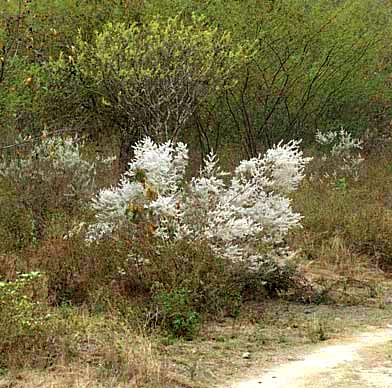
Our dry-season landscape changes week to week and it's fascinating to see how things come and go. There's always at least one species seeming to "step forward" from the landscape, drawing attention to itself as other species recede. Maybe for the whole year it'll quietly and retiringly blend with the rest of its community but then one day you're walking along and suddenly you'll notice it doing something so special that your first thought is, "Where did THIS come from?" That's the case with the above bush.
In that picture there's no doubt about which plant I'm referring to because the bush's intense silveriness imparts a sense of the plant being afire, of being like surging froth on a breaking ocean-wave. The silveriness is caused by its leaves and flowers being abundantly invested with short, soft, white, matting hairs -- "canescent," a botanist would say. You can see a close-up of Desert Lavender's pale-purple corollas arising from very hairy, canescent calyxes below:

If you know your wildflowers, a glance at the picture at the left will convince you that Desert Lavender is a member of the Mint Family. However, you might remember that Garden Lavender's flowers are arranged in an almost continuous spike -- which you can see on Wikipedia's Lavandula angustifolia page. However, Desert Lavender's flowers are clumped in whorls, or verticils, widely separated from one another along the hairy stem. Therefore, our plant isn't a "real lavender."
The local folks' Spanish name for the plant is Salvia. Well, that's fitting, since the plant looks like a member of the genus Salvia, which is the genus for Garden Sage, which also is in the Mint Family and has hoary leaves like Desert Lavender's. Also, Desert Lavender's crushed leaves emit a very pungent, eucalyptus-like odor that could be considered sage-like. However, flowers of the genus Salvia bear only two fertile stamens while Desert Lavender's tiny blossoms clearly have four. Our Salvia isn't a "real salvia."
So, what in the heck is "Desert Lavender?"
It's HYPTIS ALBIDA, a Mint-Family member of a genus not occurring in North America except along the Deep South's Coastal Plain, and the US's Desert Southwest. Hyptis, with over 300 species, is mostly tropical American, is mostly found in arid, sunny regions, and its species are mostly unarmed herbs, subshrubs and shrubs bearing essential oils.
It's those oils that make the crushed leaves smell like eucalyptus or menthol, and which assure that backcountry Mexicans regard the plants as medicinal. People here make a tea of the leaves for sore throats. The scientific literature often mentions the plant in connection with arthritis studies.
entry dated April 2, 2022, issued from near Tequisquiapan, elevation about 1,900m (6200 ft), ~N20.57°, ~ W99.89°, Querétaro state, MÉXICO
CLOSER LOOK AT DESERT LAVENDER
Fifteen years ago when the above entry was made I didn't have a camera capable of closeups. Now I do, so here's a closer look at this very interesting and pretty plant. This time the bush stepping forward was at the edge of a quarry for fill-dirt, where maybe the more exposed location caused the bush to be even whiter and woollier than the one above:
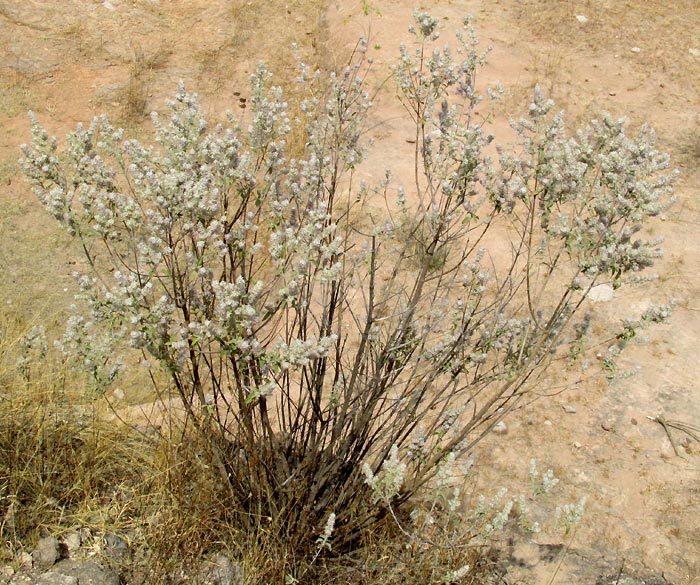
Not only is this individual woollier than the previous one, but, as seen below, its flowers are more densely packed together amide the hairiness, providing more protection to each flower from the intense sunlight and hot, dry wind at the quarry's edge:
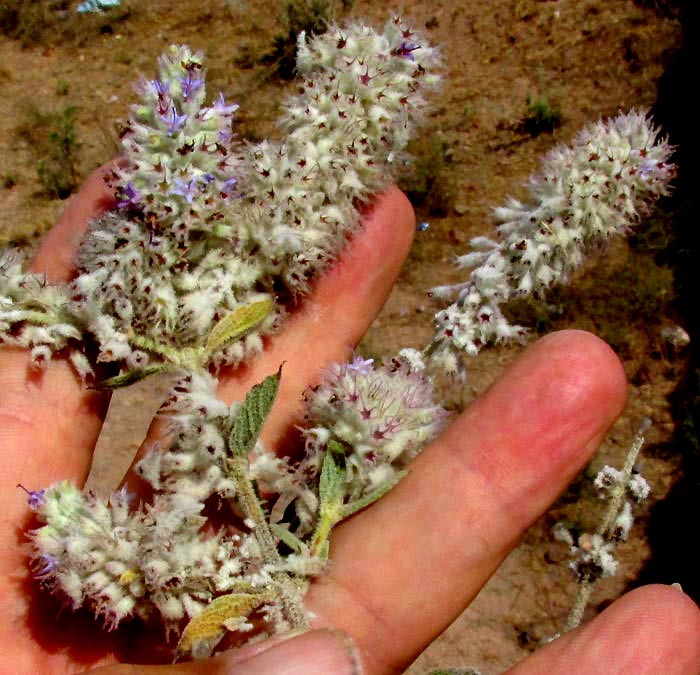
Below you see a bilaterally symmetrical, 5-lobed, pale lilac flower with its slender, dark lilac, forked style emerging, and below the flower a star-shaped calyx from which the corolla has fallen after pollination. Inside the calyx is dark purple and hairless, causing the calyx to be eye-catching when viewing the whole flower cluster from a distance:
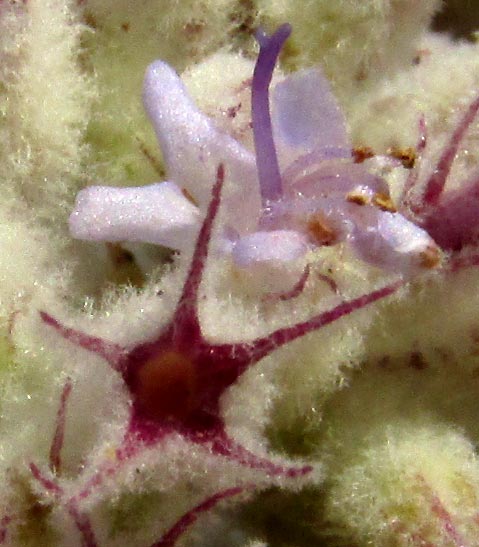
Here's what a leaf's upper surface looks like, densely covered with branching hairs:
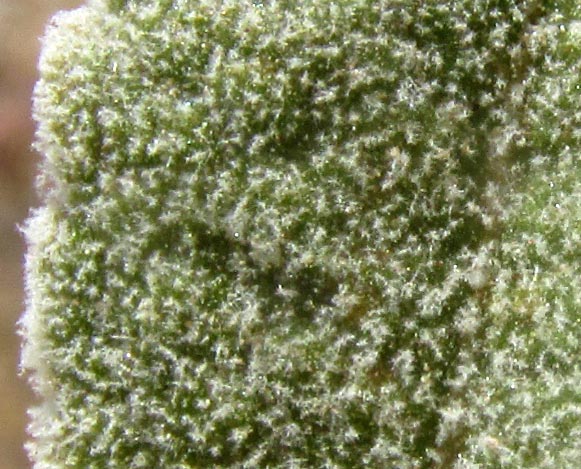
The lower leaf surface is even hairier, the branched hairs longer and matting together:
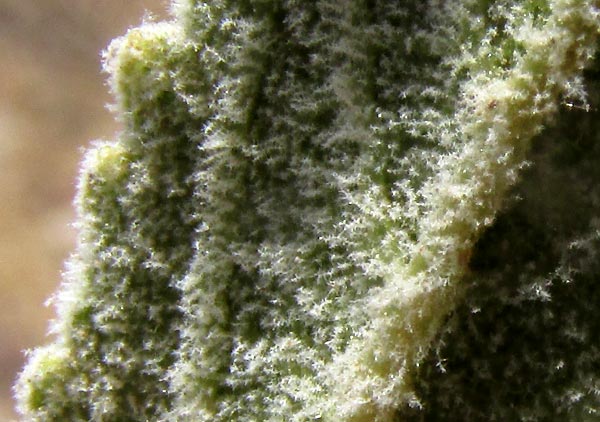
The squared stems and petioles are also densely hairy, though the hairs aren't feathery:
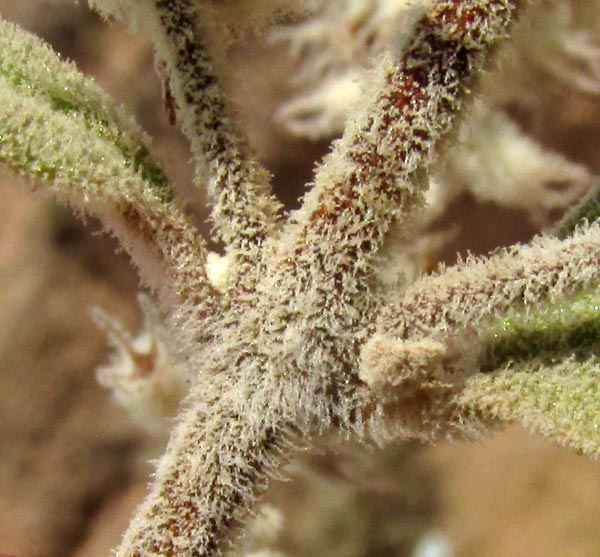
Earlier it was mentioned that traditionally this shrub's leaves, smelling like eualyptus or menthol, were used medicinally. Now more information is available on the Internet. A 2012 paper by Salud Pérez and others, entitled "Anti-inflammatory activity of Hyptis albida" described the effects of extracts made by drying and powdering the plant, and heating in water to the boiling point. Testing the effects of the resulting extract on edema induced on mouse ears, they concluded that the extract showed significant anti-inflammatory effect.
Other reports mention "teas" of the plant being used for sore throats and upset stomachs. The website "Plantas Psicoactivas de Nayarit describes the plant as a somnifero de primera calidad, a first-class sleep inducer.